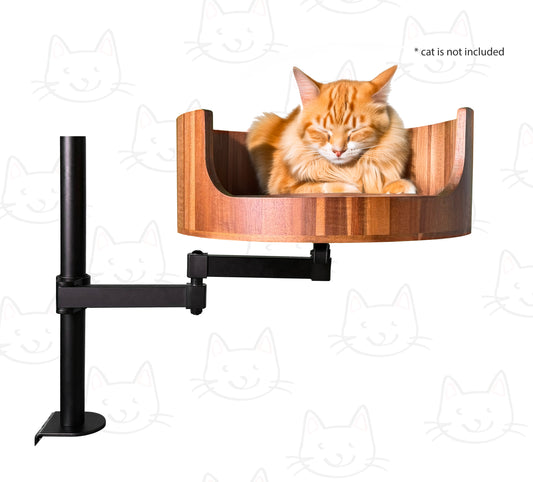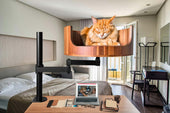
Cat Shaking Tail: Understanding Feline Communication
Share
Cat shaking tail is a common behavior that many cat owners may not fully understand. In the world of feline communication, the way a cat shakes its tail can convey a lot of information about their mood, intentions, and even potential warning signs. By learning to interpret this body language, cat owners can better understand their furry companions and strengthen their bond with them.
In this article, we will delve into the intricacies of cat tail shaking and what it means in different contexts. From playful tail flicks to aggressive tail thumping, each movement can provide valuable insights into what a cat is feeling and thinking. We will explore the various signals that cats use to communicate through their tails and provide tips on how to respond appropriately to ensure a positive and harmonious relationship with your feline friend. By the end of this article, you will have a better understanding of your cat's body language and be able to decipher the messages they are trying to convey through their tail movements.
1. Cat shaking tail can indicate a range of emotions, from excitement to aggression.
2. Pay attention to the context and other body language cues when interpreting your cat's tail movements.
3. A slow, deliberate tail shake could signal irritation or a warning.
4. Rapid tail shaking may indicate playfulness or a high level of anxiety.
5. Understanding your cat's tail language can help you better communicate and bond with your feline companion.
Understanding Feline Body Language
Feline body language is a complex system of communication that cats use to convey their emotions, intentions, and needs. One key aspect of feline body language is tail movement. When a cat shakes its tail, it is important to pay attention to the context in which this behavior occurs. Cats may shake their tails as a form of communication with other cats, with humans, or as a response to stimuli in their environment.
Causes of Tail Shaking in Cats
There are several reasons why a cat may shake its tail. It could be a sign of aggression, fear, excitement, or even playfulness. For example, a cat that is feeling threatened or agitated may shake its tail as a warning sign to stay away. On the other hand, a cat that is feeling playful and energetic may shake its tail while engaging in a game or chasing a toy. Understanding the context in which the tail shaking occurs can help decipher what the cat is trying to communicate.
Interpreting Tail Shaking in Different Situations
Tail shaking can have different meanings depending on the situation. For example, if a cat is shaking its tail while being petted, it could be a sign of overstimulation or discomfort. In contrast, if a cat is shaking its tail while hunting for prey, it could be a sign of excitement and focus. It is essential to observe the cat's body language as a whole and consider the context to accurately interpret the meaning behind tail shaking.
Responding to Tail Shaking Behavior
When a cat shakes its tail, it is essential to respond appropriately to the situation. If the cat is shaking its tail in a playful manner, you can engage in interactive play to satisfy its energy and bonding needs. However, if the cat is shaking its tail in a defensive or aggressive manner, it is crucial to give the cat space and avoid provoking further agitation. By understanding feline body language and tail shaking behavior, you can develop a closer bond with your cat and communicate effectively with them.
Frequently Asked Questions
How can Desk Cat Nest help with my cat shaking tail?
Desk Cat Nest provides a cozy and safe space for your cat to rest and relax, which can help reduce stress and anxiety that may be causing your cat to shake its tail.
Is Desk Cat Nest suitable for all breeds of cats?
Desk Cat Nest is designed to accommodate cats of all breeds and sizes. The spacious interior and comfortable cushion make it a comfortable spot for any cat to enjoy.
Will Desk Cat Nest stop my cat from shaking its tail completely?
While Desk Cat Nest can help alleviate stress and anxiety in cats, it may not completely eliminate tail shaking behavior. It is important to consult with a veterinarian to rule out any underlying medical issues causing the shaking.
How do I clean Desk Cat Nest?
Desk Cat Nest is easy to clean with a damp cloth or vacuum. The removable cushion can be machine washed for thorough cleaning.
Can Desk Cat Nest be used in conjunction with other calming products?
Yes, Desk Cat Nest can be used alongside other calming products such as pheromone diffusers or calming collars to help reduce stress and anxiety in your cat.
In conclusion, the Desk Cat Bed is a valuable choice for addressing cat shaking tail due to its comfortable and secure design that provides a sense of security and relaxation for your feline companion. By offering a cozy and elevated space for your cat to rest and observe their surroundings, this innovative cat bed can help reduce stress and anxiety, ultimately leading to a decrease in tail shaking behavior. With its durable construction and stylish appearance, the Desk Cat Bed is not only a practical solution for cat owners but also a beneficial investment in the overall well-being of your beloved pet.



















































